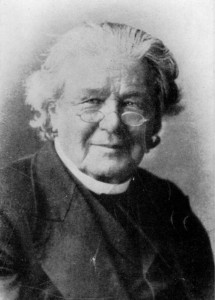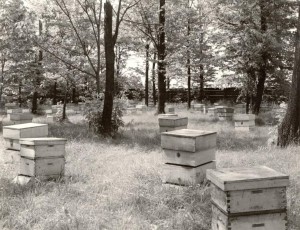“With Merry Hum”: Langstroth and the Honey Bee

Of all the insects in the world, honey bees likely generate the widest range of feelings. On the one hand, we hate their sting and their tendency to become aggressive when they feel threatened. On the other hand, we love that they provide us with a remarkable natural resource –- honey –- as well as being a key participant in the success of agriculture. How do we reconcile these disparate feelings? By better understanding honey bees… with the help of Ohio Memory!
Cave paintings dating back 15,000 years depict humans harvesting honey from wild nests, and evidence of attempts at beekeeping have been found in 7,000-year-old potsherds found in the Middle East. Early forms of beekeeping involved the use of a skep, a beehive which was either woven or formed of clay. Unfortunately, this meant that retrieving the honey required the destruction of the hive and the bees which lived there, making the process not only unhygienic but unsustainable.

In the 18th and 19th centuries, revolutionary changes in beekeeping took place. New hive designs and construction methods meant that destruction of bee colonies no longer need be a consequence of harvesting honey. It was during this period that Lorenzo Langstroth, the “Father of American Beekeeping,” designed a hive box that utilized “bee space” in its design. Langstroth, following the lead of earlier beekeepers, recognized that if bees were given only a small amount of space — one millimeter, or approximately 3/8” — in which to move about, they would leave that space free, rather than filling it with honey and other products of their work. Langstroth’s hive box contained frames that were positioned perpendicular to the base of the box, or “super,” leaving 3/8” of space between each frame. This meant that bees would deposit honey and beeswax in the frames but the frames would remain separate from each other. Beekeepers could access the hive from the top, remove frames, harvest honey and wax, and replace the frames without harming the bees or their larvae and eggs. Langstroth’s 1851 book, A Practical Treatise on the Hive and the Honey Bee (an 1863 imprint can be viewed here), details his design, as well as the lifecycle of the bee and the reasons for his hive design.

Langstroth’s hive model is still widely used today and, in fact, is a standard for beekeepers everywhere. If you’ve ever seen a box or set of stacked boxes with bees flying in and out, you’ve probably seen a Langstroth hive or one modeled after his patented design.
Ohio Memory has a small collection of items relating to beekeeping available for viewing. The photos, along with Langstroth’s book, begin to paint a picture of a culture that has been of interest to humans for thousands of years. Humans today continue to keep bees, though now easy access to honey and beeswax is not their only reason for doing so. Bees also play a crucial role in agriculture, being a primary means by which plants are pollinated. Unfortunately, bees are also facing considerable challenges, such as colony collapse disorder and diminishing populations due to pesticides and development. All the more reason to learn about, and perhaps establish homes for, these wonderful creatures!
Thank you to Shannon Kupfer, Digital/Tangible Media Cataloger at theState Library of Ohio, for this week’s post!



Leave a Reply
You must be logged in to post a comment.